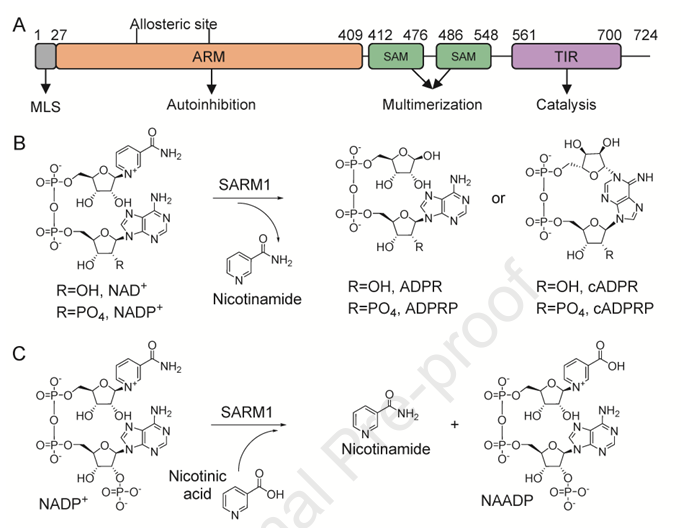Development of chemical probes to study SARM1, an NAD+ hydrolase involved in neurodegeneration
 A hallmark feature of all neurodegenerative diseases is axonal degeneration. Axonal degeneration is controlled in part by the axonal levels of nicotinamide adenine dinucleotide or NAD+. NAD+ is best known for its role in passing electrons from the citric acid cycle to the electron transport chain. However, NAD+ is also a critical cell signaling molecule that is utilized by sirtuins and PARPs. In addition to these enzymes, SARM1 catalyzes the hydrolysis of NAD+ and this activity appears to be critical for promoting axon death. Notably, SARM1 knockout mice show reduced axonal death in response to chemotherapies as well as traumatic brain injuries. Some ALS models are also protected by SARM1 knockout. Given these links, the Thompson lab is interested in understanding how SARM1 catalyzes NAD+ hydrolysis and exploiting this information for the development of SARM1 inhibitors. We are also interested in understanding how this protein is regulated in cells. Notably, the Thompson lab was the first to show that a liquid to solid phase transition could activate SARM1 activity by up to 2000-fold. We also showed that this phase transition could potentiate the effect of a known allosteric activator, i.e. NMN, by lowering the concentration of NMN required to activate SARM1. Current efforts are focused on determining the full scope of the reactions catalyzed by SARM1 and developing inhibitors for this enzyme.
A hallmark feature of all neurodegenerative diseases is axonal degeneration. Axonal degeneration is controlled in part by the axonal levels of nicotinamide adenine dinucleotide or NAD+. NAD+ is best known for its role in passing electrons from the citric acid cycle to the electron transport chain. However, NAD+ is also a critical cell signaling molecule that is utilized by sirtuins and PARPs. In addition to these enzymes, SARM1 catalyzes the hydrolysis of NAD+ and this activity appears to be critical for promoting axon death. Notably, SARM1 knockout mice show reduced axonal death in response to chemotherapies as well as traumatic brain injuries. Some ALS models are also protected by SARM1 knockout. Given these links, the Thompson lab is interested in understanding how SARM1 catalyzes NAD+ hydrolysis and exploiting this information for the development of SARM1 inhibitors. We are also interested in understanding how this protein is regulated in cells. Notably, the Thompson lab was the first to show that a liquid to solid phase transition could activate SARM1 activity by up to 2000-fold. We also showed that this phase transition could potentiate the effect of a known allosteric activator, i.e. NMN, by lowering the concentration of NMN required to activate SARM1. Current efforts are focused on determining the full scope of the reactions catalyzed by SARM1 and developing inhibitors for this enzyme.
